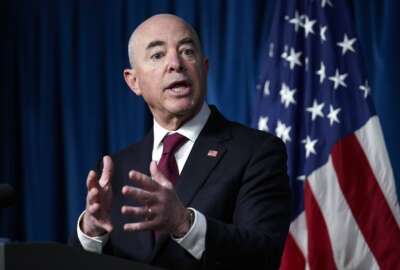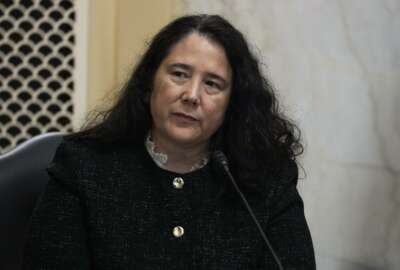President’s management agenda benefits from being specific
The Biden administration's management agenda, which the White House built out with a lot of detail last week, focuses on just three things.
Best listening experience is on Chrome, Firefox or Safari. Subscribe to Federal Drive’s daily audio interviews on Apple Podcasts or PodcastOne.
The Biden administration’s management agenda, which the White House built out with a lot of detail last week, focuses on just three things. And that’s a wise approach according to my next guest. The Federal Drive with Tom Temin get some perspective from our longtime federal management scene observer, Bob Tobias.
Interview transcript:
Tom Temin: And Bob, the idea that it is narrowly focused makes sense to you. Tell us more.
Bob Tobias: Well, I think that past presidents when they’ve created their management agenda have been all over the board. So nobody really knew where to focus their attention. And I think by reducing to three priority goals – one, strengthening the federal workforce; two, improving federal service delivery and customer experience; and three, managing the business of government – he has nailed what is most important to effectively implement service to the public. And so people can remember and focus on those three goals.
Tom Temin: Now, those goals, yes, there’s only three of them but each one is pretty big, though and ambitious by itself, isn’t it?
Bob Tobias: It is. But he has created an infrastructure of support unlike other presidents. He has people who are called priority area leads, and then under them strategic leads from across the government. In the past, a president’s management agenda was driven solely by OMB. And there’s not much love between OMB and agencies. This plan relies on the agencies and these priority leads and strategy leads to implement his agenda. Now, what he didn’t do was speak directly to federal employees about this agenda. So they had no role in creating this agenda. But he does insist that employees and employees represented by unions to be included in how each agency will actually achieve the goals. And I think that’s a real plus, because it’s consistent with a federal employee viewpoint survey. So for example, 66% of federal employees strongly agree or agree that “I am encouraged to come up with new and better ways of doing things.” So 66% of people are already interested in doing new and better things. This will build that willingness to participate and be involved. If there’s one other question that I think that’s important, 74% strongly agree or agree that “My work gives me a sense of personal accomplishment.” So if that’s the case, it’s clear that federal employees want to accomplish service to the public, and being given an opportunity to do it is a very, very good thing.
Tom Temin: I didn’t check the math but my first question of the Deputy Director for Management Jason Miller, when I interviewed him last week, was at the top level, the people assigned are political appointees. At that second level that you mentioned, the strategy leaders, he said, most of them are, in fact career, and that is by design, because really, without the career workforce involved whether bargaining unit, or senior management counts also, that nothing really does happen. Fair assessment?
Bob Tobias: It is, because if it’s political appointees driving the train, only driving the train, they come they go, they’re not often really paying attention. But the career folks are here for a time. They’re really, really interested in doing governance better. So I think it was a very wise strategy that he put in place.
Tom Temin: The whole effort in some ways reminds me, it has the tone of the National Partnership for Reinvention of Government during the Clinton administration. Did it strike you that way?
Bob Tobias: It does, it really does. I think that’s an acute observation, Tom, because it is across the government. It does involve career leaders. It does involve employees, and the focus is on, I believe, noncontroversial efforts to improve government service. So I think it does mirror much of President Clinton’s initiative.
Tom Temin: Although President Clinton said government was too big and cost too much. This group seems to think it can’t get big enough or spend enough. We’re speaking with Bob Tobias, he’s a professor in the Key Executive Leadership Program at American University. And the idea of having metrics assigned to each goal, I think, probably is another stroke of brains here, because without metrics, anything is possible and nothing is possible.
Bob Tobias: Yes. And there are metrics and they’re simple. I mean, for example, the priority to strengthen the federal workforce has a goal that “Agencies will develop equitable, transparent and transferable career development pathways that promote career growth and agency mission delivery.” All right, that’s kind of unclear. But the metric is, “Increase opportunities for skill development and flexible pathways, as measured by an increase in the percentage of employees who agree to the Federal Employee Viewpoint question: ‘I am given a real opportunity to improve my skills, my organization.'” Very, very simply measured, and it’s measured on an annual basis. And the Biden administration can see whether that’s heading in the right direction or the wrong direction. So it’s simple. It’s measurable, it’s objective, and it’s either being done or not.
Tom Temin: Right. They’re not inventing new needles here, they’re actually trying to move the needles that everyone already agrees are accurate measures of what’s going on.
Bob Tobias: That’s exactly right. Yes, this plan’s, I think, value builds on what is there, it builds on the desires of federal employees generally. And the progress is easily measured.
Tom Temin: And in your experience, these types of initiatives, once they become something that is owned by career, federal employees may transcend changes in leadership, not so much necessarily the change in administration. But say there’s two terms as there have been most of the last several presidencies, the political leadership comes and goes at the agency level, but the initiatives do have a chance of carrying on through at least the length of that administration.
Bob Tobias: Well, one of the, I think, problems with the president’s plan is that the plan itself is not time bound. So people don’t have a specific time set out as to when these goals should be met. But the fact is, the measures that have been created can be looked at every single year. And as I said, they’re either going up or they’re going down, or they’re staying the same. So even though they’re not specifically time bound, they can be measured over time. And as you suggest, if they are indeed adopted by the career workforce, will live through changes in administration.
Tom Temin: Bob Tobias is a professor in the Key Executive Leadership Program at American University. As always, thanks.
Bob Tobias: Thank you, Tom. It’s a pleasure.
Copyright © 2025 Federal News Network. All rights reserved. This website is not intended for users located within the European Economic Area.
Tom Temin is host of the Federal Drive and has been providing insight on federal technology and management issues for more than 30 years.
Follow @tteminWFED






